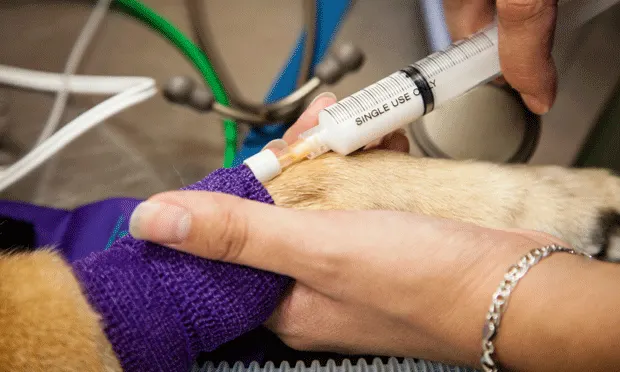Top 5 Mistakes Made in Veterinary Emergency Rooms

You have asked…What are the most common errors made in the emergency room, and how can I avoid them?
The expert says…Emergencies are common daily occurrences seen in general, specialty, and emergency practice. Following are simple tips on how to avoid common clinical errors with emergent patients.
1. Using THE ENTIRE shock dose of fluids
Shock is defined as cellular hypoxia, regardless of shock type (ie, cardiogenic, hypovolemic, distributive, metabolic, hypoxemic). When practitioners are presented with a “shocky” patient (tachycardic, hypotensive, poor perfusion), they need to rule out cardiogenic shock (eg, myocardial failure secondary to dilated cardiomyopathy), as the other types of shock generally require IV fluid therapy as part of the primary intervention to volume resuscitate the patient.
Using the entire shock dose of IV fluids in emergency medicine is no longer considered a standard of care. Traditional shock dose is extrapolated from the total blood volume of the patient (dogs, 60–90 mL/kg; cats, 60 mL/kg). A patient rarely requires replacement of its entire blood volume with crystalloid fluids. Instead of immediately using a whole shock dose, using smaller, repeated aliquots of IV crystalloids (over 20–30 minutes) is recommended.
Related Article: Sedation & Analgesia for Canine Emergencies
Hint: Simply adding 0 to the dog’s weight in pounds results in a conservative shock bolus, equating to a 22 mL/kg bolus (eg, 70 lb + 0 = 700 mL).
The use of one-quarter to one-third of a shock bolus of a balanced, maintenance crystalloid over 20 minutes can be implemented in shocky patients, followed by frequent reassessment of perfusion parameters: Has heart rate or mentation improved? Has capillary refill time or pulse quality improved?
If minimal to no clinical response is seen, repeated aliquots are indicated until appropriate volume resuscitation has occurred.
2. Not Knowing about the “Poor Man’s Dinamap”
In the patient presenting with shock, pulse quality should be assessed by palpating the femoral pulse. Pulse palpation, quality, and duration are a gross estimate of blood pressure and stroke volume (indirectly).
If an animal appears healthy, pulses should be strong and synchronous with a palpable pulse for each heartbeat; therefore, one should auscultate the cardiopulmonary system while the femoral pulse quality is being palpated.
A palpable femoral pulse is consistent with systolic blood pressure of ≥60 mm Hg (≥8 kPa). A palpable dorsal metatarsal pulse is consistent with a systolic blood pressure of ≥90 mm Hg (≥12 kPa) and can be used as a basic “poor man’s Dinamap.” This acts as a simple, easily repeatable tool to assess response to volume resuscitation during shock, particularly when blood pressure monitoring is not readily available.
3. Not Using Simple IN-HOUSE tests to evaluate hydration
When a patient is on IV fluids, blood work should be performed daily to assess hydration. Minimum database should include PCV, total solids (TS), blood glucose (BG), BUN, and sodium and potassium levels. Urine specific gravity (USG) measurement is an additional simple assessment of hydration in a normal, healthy patient (ie, excluding patients with underlying disease that may affect USG [renal disease, hyperthyroidism, diabetes mellitus]). Evaluating PCV, TS, and USG daily helps ensure appropriate hydration.
For example, if a clinically healthy patient on IV fluids still has normal PCV, TS, and USG (eg, PCV = 48%, TS = 7.4 g/dL [74 g/L], USG = 1.025) after 12 to 24 hours of IV fluids, the patient is still inappropriately hydrated (at sea level); more aggressive fluid therapy may be indicated to maintain hemodilution. Ideally, the goal is to achieve a hemodiluted, hydrated state (eg, 35% PCV,5 g/dL [50 g/L] TS, <1.018 USG).
Electrolytes should be monitored daily in patients on IV fluids. Sodium should be evaluated to ensure that rapid shifts do not occur; changes of >0.5 mEq/L/hr (>0.5 mmol/kg/hr) in sodium levels can result in cerebral edema or fluid shifts into the brain, particularly in chronically dehydrated patients. Potassium should be evaluated daily while patients are on IV fluids, as balanced, maintenance crystalloids are typically potassium poor and additional potassium supplementation is often necessary.

4. Inducing Emesis Improperly
Patients are often presented for accidental home poisoning. Two key mistakes commonly seen by Animal Poison Control Centers are 1) inducing emesis with the wrong emetic, and 2) being unfamiliar with emesis contraindications (see Contraindications to Emesis Induction, below).
Emesis should only be induced in asymptomatic patients with recent ingestion (≤1 hour) of the toxicant. In clinic, apomorphine or hydrogen peroxide can be safely used; other emetic agents such as salt, syrup of ipecac, and mustard are no longer considered the standard of care. At home, the only emetic agent recommended for dogs is hydrogen peroxide.
For cats, there is no reliable or safe at-home emetic agent. In cats, routine use of apomorphine, salt, and hydrogen peroxide are not warranted, as they are ineffective and may result in adverse effects (eg, hypernatremia, hemorrhagic gastritis). α2-Adrenergic agonists can be used in the veterinary setting if the time frame is appropriate (eg, recent ingestion, asymptomatic patient).
Contraindications to emesis induction
Symptomatic poisoned patient
≥1 hour since ingestion
Brachycephalic breed
Decreased gag reflex or level of consciousness
Ingestion of the following toxicants:
Salt (eg, table salt, paint balls, homemade play dough)
Corrosive or caustic agents
Hydrocarbons (eg, gasoline, kerosene, motor oil)
Underlying medical problems predisposing the patient to aspiration:
Megaesophagus
Laryngeal paralysis
History of aspiration pneumonia
5. Hesitating to Perform Thoracentesis
Many clinicians are hesitant to perform thoracentesis because of its invasiveness. However, diagnostic and therapeutic thoracentesis is often life-saving and should be performed immediately in any dyspneic patient suspected of having pleural space disease (eg, pneumothorax, pleural effusion).
Related Article: Thoracocentesis
When performing thoracentesis, aseptic technique should be used. The patient should be shaved, scrubbed, and prepared for sterile technique. A 3-way stopcock, extension tubing, appropriately sized needle or catheter, and syringe should be used to collect air or fluid. Typically for cats, a 1-inch (25-mm), 22-gauge needle or butterfly catheter can be used. For dogs, a 1.5-inch (25-mm), 18- to 22-gauge needle can be used, depending on the dog’s size. Appropriate sterile collection tubes should be available for sample collection for cytology and/or culture.
Thoracentesis should be performed with the patient in sternal or lateral recumbency at the 7th to 9th intercostal space (ICS) to avoid the heart (3rd–5th ICS) or liver (caudal to the 9th ICS) and should occur cranial to the rib (or within the ICS). If pleural effusion is present, the needle should be directed into the ventral third of the chest cavity; if pneumothorax is suspected, the dorsal third of the chest cavity should be used.
In an emergency, a simple way of identifying where to perform thoracentesis is to draw an imaginary line straight up the lateral body wall at the caudal aspect of the xiphoid. This is approximately the 8th ICS and is the general area where thoracentesis should be performed.
Closing Remarks
While emergencies may be stressful, clinicians can improve the outcome in emergent patients by implementing newer modalities of emergency and critical care.
JUSTINE A. LEE, DVM, DACVECC, DABT, is the CEO and founder of VetGirl, a subscription-based podcast service offering RACE-approved continuing education (CE). Dr. Lee graduated from Cornell University and completed her internship at Angell. She also completed an emergency fellowship and residency at University of Pennsylvania. Dr. Lee is double-boarded in both emergency critical care and toxicology. In 2011, she was named the NAVC Conference Small Animal Speaker of the Year, and she is passionate about delivering clinically relevant CE.